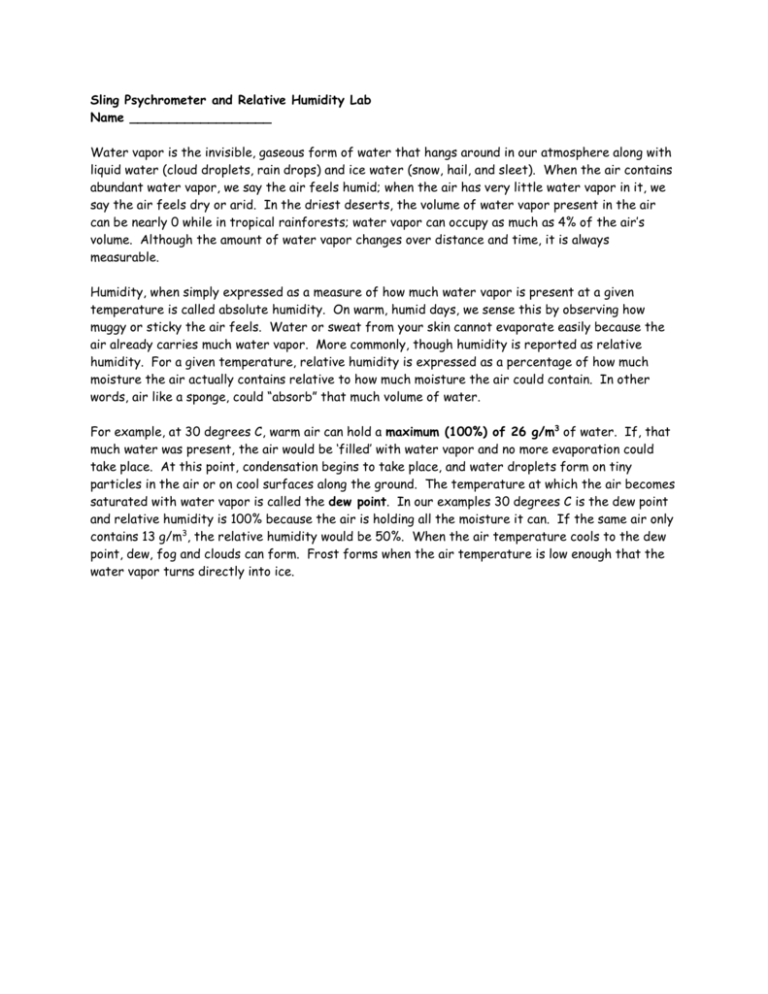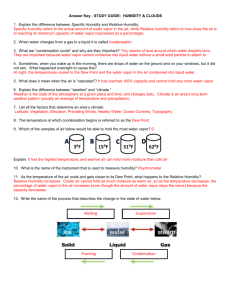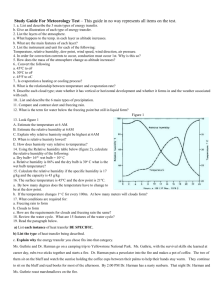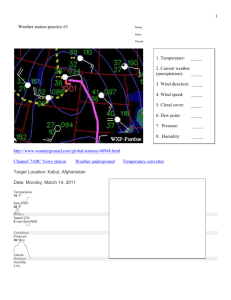Sling Psychrometer & Relative Humidity Lab Worksheet
advertisement

Sling Psychrometer and Relative Humidity Lab Name __________________ Water vapor is the invisible, gaseous form of water that hangs around in our atmosphere along with liquid water (cloud droplets, rain drops) and ice water (snow, hail, and sleet). When the air contains abundant water vapor, we say the air feels humid; when the air has very little water vapor in it, we say the air feels dry or arid. In the driest deserts, the volume of water vapor present in the air can be nearly 0 while in tropical rainforests; water vapor can occupy as much as 4% of the air’s volume. Although the amount of water vapor changes over distance and time, it is always measurable. Humidity, when simply expressed as a measure of how much water vapor is present at a given temperature is called absolute humidity. On warm, humid days, we sense this by observing how muggy or sticky the air feels. Water or sweat from your skin cannot evaporate easily because the air already carries much water vapor. More commonly, though humidity is reported as relative humidity. For a given temperature, relative humidity is expressed as a percentage of how much moisture the air actually contains relative to how much moisture the air could contain. In other words, air like a sponge, could “absorb” that much volume of water. For example, at 30 degrees C, warm air can hold a maximum (100%) of 26 g/m3 of water. If, that much water was present, the air would be ‘filled’ with water vapor and no more evaporation could take place. At this point, condensation begins to take place, and water droplets form on tiny particles in the air or on cool surfaces along the ground. The temperature at which the air becomes saturated with water vapor is called the dew point. In our examples 30 degrees C is the dew point and relative humidity is 100% because the air is holding all the moisture it can. If the same air only contains 13 g/m3, the relative humidity would be 50%. When the air temperature cools to the dew point, dew, fog and clouds can form. Frost forms when the air temperature is low enough that the water vapor turns directly into ice. Pre-Lab 1. Compare the humidity between a summer day in Miami Florida, with that of Phoenix Arizona. Which city would you predict would have a higher humidity? Why? 2. Define the following terms: a. humidity: b. Relative humidity: 3. The same air as described above now contains 6.5g/m3. a. What is the relative humidity now? b. How would this air feel on your skin? c. How would your skin feel if the same air cooled to the dew point? How it works 1. When water evaporates, heat is required to change water into water vapor. As a result, evaporation has a definite cooling effect. Think about how you feel when you get out of a pool on a warm day. The ‘chilled’ feeling is the cooling effect of water evaporating from your skin. 2. Warm air holds more moisture than cool air. In fact, air at near room temperature, 20 degrees C or 68 degrees F, holds twice as much water vapor as air at 10 degrees C or 50 degrees F. That is why during sticky summer days, a sudden drop in temperature often brings welcome relief from the high humidity. What to do: 1. Wet the cloth covering one the end of one thermometer. 2. Make sure that both thermometers are securely attached to the backing device, then carefully whirl the two thermometers in the air for about 30 seconds. 3. Immediately after whirling, record the temperatures indicated on both thermometers. 4. The difference between the readings on the wet and dry bulb thermometers is a measure of the amount of heat energy that is needed at the wet-bulb temperature to produce air saturated with water vapor. This measure is termed wet-bulb depression. Investigation 1: Relative Humidity 1. Using the Relative Humidity Chart (https://goo.gl/Ovg6CB) follow the row containing the dry-bulb temperature until you reach the intersection of the column containing the webbulb depression. 2. The resulting value is the relative humidity. Record the result on your worksheet. Trial Number Dry-Bulb Reading 1-inside 2-outside Wet-Bulb Reading Degrees C Degrees C Wet-Bulb Depression (dry bulb temp – wet bulb temp) Degrees C Degrees C Degrees C Degrees C Relative Humidity (from chart):______________% Investigation 2: Dew Point 1. From your previous investigation, re-record the values of the dry-bulb or air temperature (and the wet-bulb depression onto your worksheet. 2. To determine the dew point temperature, find the dry-bulb (air temperature) along the left column of the Dew Point Chart (https://goo.gl/Ovg6CB) 3. Next, find the vertical column that corresponds to the relative humidity you found above. Trace your fingers to find where these two numbers meet. This value is the Dew Point. 3. Record this value on your worksheet. Trial Number Dry-Bulb Reading From above 1- Inside 2- Outside 1. Degrees C Degrees C Relative Humidity (from chart) % % Dew Point (from Chart) Degrees C Degrees C Why does the temperature decrease on the wet-bulb thermometer? 2. What would happen if the air in this room suddenly cooled to the dew point? 3. What does it mean if the water does not evaporate from the wet-bulb thermometer? 4. Why should you not perform this experiment in direct sunlight? 5. Can a sling psychrometer be used when the temperature is below freezing? Why or why not? 6. Why is learning about the psychorometer important? Minnesota summers can get fairly humid. Many outdoor workers can get overheated and very sick from being too hot or getting dehydrated from a combination of temperature and humidity. A few people in Minnesota die every summer from heat stroke. It is very important to stay hydrated in the hot weather especially if you are exercising. But, as the humidity increases our bodies are not able to cool down because the sweat we make is not able to evaporate. In that case, no matter how hydrated a person is they are just not able to cool down and should rest in the shade or get to a cool place. Use the Heat Index chart to answer questions on the next page. Heat Index T e m p e r a t u r e 25 30 35 40 45 Relative Humidity (%) 50 55 60 65 70 12 5 12 0 11 5 11 0 10 5 10 0 95 13 9 12 7 11 7 10 9 10 1 94 14 8 13 5 12 3 11 3 10 4 96 14 3 13 0 11 8 10 7 98 90 88 90 91 15 1 13 7 12 3 11 0 10 1 93 14 3 12 9 11 5 10 4 95 15 0 13 5 12 0 10 7 96 14 2 12 6 11 0 98 85 83 84 85 86 87 88 80 75 70 77 72 66 78 73 67 79 73 67 79 74 68 80 74 68 81 75 69 75 80 85 90 95 10 0 12 2 10 2 88 79 71 10 5 89 79 71 10 8 91 80 72 89 14 9 13 2 11 4 10 0 90 13 8 11 9 10 2 91 14 4 12 4 10 6 93 13 0 10 9 95 13 6 11 3 97 11 7 99 81 75 69 82 76 70 83 76 70 85 77 70 86 77 70 86 78 71 87 78 71 6. Many employers allow outdoor workers to choose to go home or work indoors if the heat index gets above 100 degrees F. If the air temperature is 90 degrees, what would the relative humidity need to be to send workers home? 7. If the relative humidity is 90%, and you own a construction company, what would the temperature be for you send your workers home? 8. Why does it feel so hot when the humidity is high, even though you are sweating a lot? 9. If you have a glass of ice water outside on a hot day, sometimes people say the glass is sweating. What is really happening to the glass of water? Name:_______________________ Period:_________ Dew Point Temp Worksheet Complete the chart below using the Tables here: https://drive.google.com/open?id=0B6m8u4tWlEvkQV9lajRfbzNYdzA&authuser=0 Note the Wet Bulb Depression is the difference between the wet-bulb and dry-bulb thermometers . Air Temp (C) Wet Bulb Temp (C) 1 2 3 4 5 6 7 8 18 28 14 8 0 -11 15 14 13 26 8 4 -3 -12 10 10 Diff. betw. Dew Point wet and dry Temperatur bulb e (C) (C) Relative Humidity Worksheet Complete the chart below using the Tables linked above. Air Temp (C) 1 2 3 4 5 6 7 8 24 28 20 4 19 15 23 0 Wet Bulb Temp (C) 16 18 17 -1 16 10 21 -3 Wet Bulb Depression (C) Relative Humidity (%) For questions #1-10, refer to the graph below, which shows the hourly surface temperature, dew point, and relative humidity for a twenty-four hour period during the month of May. 100 90 80 70 Relative Humidity (%) 60 Air Temp. (F) 50 Dew Point Temp. (F) 40 30 12:00 AM 8:00 PM 4:00 PM 12:00 PM 8:00 AM 4:00 AM 12:00 PM 20 1. The lowest air temperature occurred at what time? 2. The highest relative humidity reading occurred at what time? 3. The highest air temperature occurred at about what time? 4. The lowest relative humidity occurred at about what time? 5. According to the graph, what happens to the relative humidity as the air temperature increases? 6. At what time(s) did the air temperature equal the dew point? 7. What was the relative humidity (%) when the air temperature equaled the dew point? 8. Condensation (water coming out of the air) is most likely to occur at approximately what time? 9. At approximately what time was the rate of evaporation highest? 10. The greatest change in air temperature occurred during the period from: A) midnight to 6AM C) noon to 6PM B) 6AM to noon D) 6PM to midnight 10





